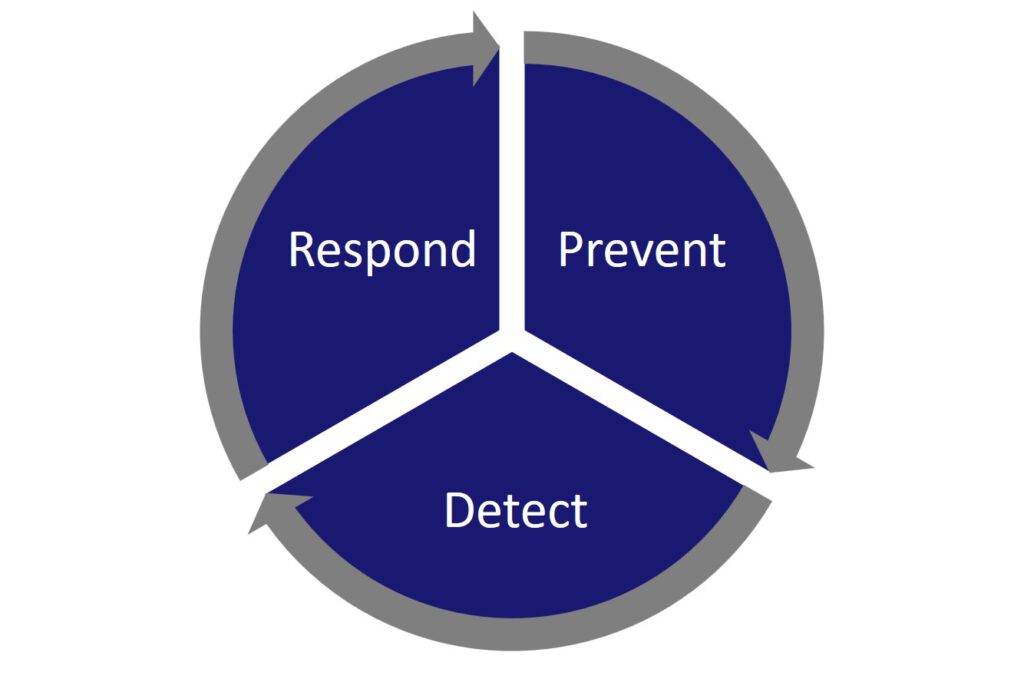
Contents
Prevent, Detect & Respond
Dive into the depth of the ‚Prevent, Detect, and Respond‘ approach, a pivotal methodology in managing Internal Control Systems (ICS) across diverse business areas. This framework ensures organizations are adeptly equipped for risk management, compliance, and operational integrity.
Prevent: Proactive Measures for Organizational Security
1. Risk Management:
- Goal: Mitigate potential risks before they manifest.
- Methods: Conducting thorough risk assessments, implementing mitigation strategies, and continuous risk monitoring.
- Outcome: A robust risk-aware culture, minimizing potential threats and enhancing resilience.
- Goal: Ensure strict adherence to legal and regulatory standards.
- Methods: Developing comprehensive compliance policies, regular training, and implementing monitoring systems.
- Outcome: Strong regulatory compliance, reducing legal risks and fostering ethical practices.
3. AML & CTF:
- Goal: Prevent financial crimes and terrorism financing.
- Methods: Implementing KYC procedures, conducting transaction monitoring, and legal compliance checks.
- Outcome: A fortified stance against financial crimes, ensuring adherence to AML/CTF regulations.
4. Anti-Fraud:
- Goal: Deter fraudulent activities and protect organizational assets.
- Methods: Setting up robust internal controls, fraud detection systems, and conducting regular audits.
- Outcome: Significant reduction in fraudulent activities and enhanced financial security.
- Goal: Combat the production and distribution of counterfeit products.
- Methods: Employing product security features, conducting market surveillance, and taking legal actions against infringements.
- Outcome: Protection of brand integrity and prevention of revenue loss due to counterfeits.
6. Grey Imports and Parallel Markets:
- Goal: Curtail unauthorized imports and parallel market distributions.
- Methods: Enforcing strict distribution agreements, monitoring supply chains, and implementing market segmentation strategies.
- Outcome: Effective control over product distribution, maintaining market stability and brand reputation.
7. BCM:
- Goal: Ensure business operation continuity during disruptions.
- Methods: Developing comprehensive BCM plans, conducting regular drills, and establishing effective communication channels.
- Outcome: Minimized operational disruptions and quicker recovery post-incident.
8. COM:
- Goal: Efficiently manage and oversee outsourced functions.
- Methods: Rigorous vendor vetting, setting clear SLAs, and continuous performance monitoring.
- Outcome: Optimized outsourcing relationships, ensuring quality and compliance.
9. Data Protection:
- Goal: Safeguard sensitive data from unauthorized access and breaches.
- Methods: Implementing data encryption, access controls, and regular data privacy training.
- Outcome: Enhanced security of sensitive data, ensuring privacy and regulatory compliance.
10. Information Security:
- Goal: Protect digital assets and information systems.
- Methods: Utilizing firewalls, antivirus software, and conducting regular cyber threat assessments.
- Outcome: Robust defense against cyber threats, maintaining data integrity and confidentiality.
Detect: Identifying Risks and Non-compliance
1. Risk Management: Early detection of potential risks through continuous monitoring and reporting systems.
2. Compliance Management: Identifying compliance breaches through audits and regular policy reviews.
3. AML & CTF: Detecting unusual transaction patterns and potential financial crimes.
4. Anti-Fraud: Uncovering fraudulent activities through sophisticated detection technologies.
5. Anti-Counterfeiting: Identifying counterfeit products in the market through surveillance and intelligence.
6. Grey Imports and Parallel Markets: Detecting unauthorized imports and sales through market analysis and monitoring.
7. BCM: Recognizing early signs of operational disruption and implementing corrective measures.
8. COM: Identifying issues in outsourced services through performance reviews and audits.
9. Data Protection: Detecting unauthorized data access or breaches through monitoring tools and data analysis.
10. Information Security: Identifying cybersecurity threats and vulnerabilities through continuous system monitoring.
Respond: Effective Management and Resolution
1. Risk Management: Implementing response strategies to mitigate identified risks.
2. Compliance Management: Addressing compliance issues through corrective actions and policy revisions.
3. AML & CTF: Responding to detected financial crimes with investigation and legal reporting.
4. Anti-Fraud: Taking legal actions against fraudulent activities and enhancing control measures.
5. Anti-Counterfeiting: Legal enforcement against counterfeiters and public awareness campaigns.
6. Grey Imports and Parallel Markets: Legal actions and supply chain adjustments to curb unauthorized sales.
7. BCM: Executing business continuity plans to ensure operational stability during crises.
8. COM: Revisiting and adjusting outsourcing strategies based on performance issues.
9. Data Protection: Responding to data breaches with incident management and recovery plans.
10. Information Security: Countering cybersecurity threats with immediate action and system fortifications.
The ‚Prevent, Detect, and Respond‘ framework is an integral part of modern ICS, providing a structured and dynamic approach to handling diverse organizational challenges. By adopting this framework, your organization can enhance its security, compliance, and operational resilience.
Explore further at Internal-Control-System.com/prevent-detect-respond to integrate this comprehensive framework into your organization’s strategy for a secure, compliant, and resilient operational environment.